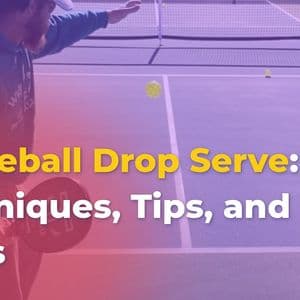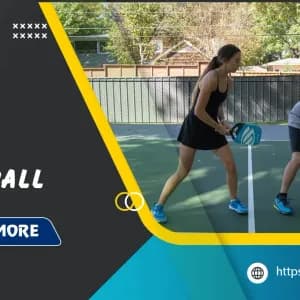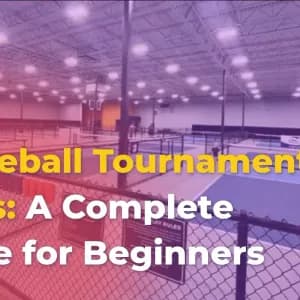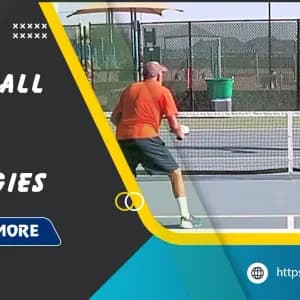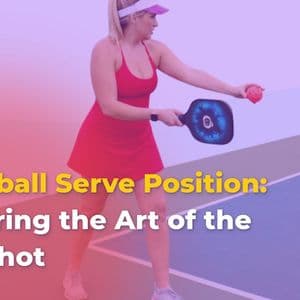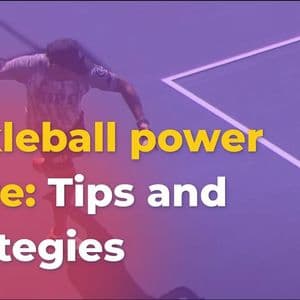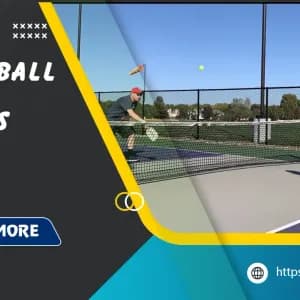"Let" serves: Understanding the old rule and the new
The term “let” finds its roots in the world of tennis, where it denotes a specific situation in which a serve grazes the top of the net yet still lands within the appropriate area. In the context of pickleball, the let rule was inherited, allowing players to call for a re-serve in this scenario. However, as the game evolved, so did its regulations. In 2021, the USA Pickleball Association officially removed the let rule, ushering in a new era where any serve touching the net yet landing correctly is considered valid and play continues uninterrupted.
The change was embraced with open arms by many, yet it demands a shift in mindset, particularly for players accustomed to the more traditional rules. With the elimination of the let, the atmosphere surrounding a pickleball match transformed from one steeped in formality to a more fluid and dynamic experience. Players must now adapt to understanding that a serve that grazes the net is no longer a cause for hesitation it’s simply part of the game.

What is a let in pickleball?
Historically, the concept of a let in pickleball mirrored its implementation in tennis, where precision and replays governed the action. Whenever a serve hit the net and still landed in the designated service court, players would raise their hands, calling for a let, thereby allowing for a redo of the serve. This practice was somewhat beneficial in erasing potential mistakes; however, it also opened the door to numerous disputes and prolonged stoppages during matches.
The transition away from the let rule signifies a cultural shift. It mirrors a broader trend in sports favoring flow and continuity over rigid adherence to outdated regulations. Players can now imbibe the essence of pickleball more fully, each serve becoming an opportunity to showcase their skills rather than a potential source of contention and interruption.
The current rule: Net serves are legal and live
In the modern context of pickleball, the implications of the updated serving rules are significant. Players no longer worry about calling a let; instead, they must remain vigilant and ready to engage with each serve, net touches included. As long as the ball lands within the confines of the correct service area, it is deemed valid, promoting an uninterrupted and lively exchange.
To visualize this clearly, consider a diagram of the pickleball court illustrating the service areas each court divided diagonally, with personal boundaries behind the non-volley zone (or “kitchen”). This diagram emphasizes how, in contemporary pickleball, net serves that hit the top yet fall correctly are celebrated as active plays instead of signals for a redo. This reflects a modern and engaging approach to the game, enhancing players' experiences and choices during match play.
Why the "let" rule changed (and why it's better now)
The shift away from the let rule in pickleball isn't merely an arbitrary decision; it is a strategic move aimed at enhancing the game’s overall experience. By eliminating the let, the essence of pickleball fast-paced action and competitive spirit is preserved.

Faster games and fewer stoppages
The removal of the let rule has one clear and undeniable impact: it speeds up gameplay. With fewer stoppages for re-serving, players can dive into the game’s rhythm much quicker. Each serve brings excitement rather than dread, as the flow of the match becomes consistent. This change allows players to build momentum, enhancing the thrill of rallies and confrontations on the court.
Moreover, the impact isn’t limited solely to the pace of the game it also infuses matches with a sense of urgency, compelling players to remain engaged and focused. Think of it like a high-octane film; every scene flows seamlessly into the next, creating tension and thrill without interruptions that can potentially disrupt the overall experience.
Less confusion, more fun
For the newer players dipping their toes into pickleball waters, the updated rules simplify the learning process significantly. Beginners often find their footing in the game when they don’t have to navigate complex rules and nuances that can lead to disputes with opponents. The elimination of the let rule mitigates potential confusion, fostering an environment where players can focus on honing their skills and improving their game rather than parsing through technicalities.
The strategic genius of this change lies in its ability to streamline the experience, allowing recreational players and serious competitors alike to relish each moment. Just as a great melody flows without pause, this new rule mirrors that fluidity, inviting everyone on the court to bask in the joy of the game rather than get caught up in disputes.
How to handle a serve that hits the net
Navigating the nuances of pickleball's evolving rules can be a challenge, particularly for beginners. However, being prepared for the unexpected can enhance gameplay, turning potentially confusing scenarios into opportunities for tactical advantage.

For the receiver: Be prepared for anything
With net serves now in play, receivers must develop a robust readiness to react to unpredictable bounces. A ball striking the net can ricochet in ways that surprise even the most seasoned players, making footwork and positioning critical. It is essential for receivers to keep their feet light and engage in active movement, always maintaining a stance to respond rapidly.
Attempting to anticipate the direction of the serve can significantly contribute to better performance. Establishing a keen observational capacity while reading the server’s body language can give receivers a slight edge in preparing themselves for quick reactions, ultimately allowing them to seize control during rallies.
For the server: A chance to take control
On the other side of the net, serving brings with it unique strategic opportunities. The ability to engage with a net serve can be harnessed as a valuable weapon. Many players have begun to experiment with varied serve techniques, including what some call the “nasty Nelson.” This maneuver capitalizes on the unpredictability of net serves, catching unsuspecting receivers off guard.
Incorporating drills to practice different serving styles not only keeps the server’s repertoire fresh but also presents challenges for opponents. Much like a chess game, employing diverse strategies during serves adds depth and complexity to the match while instilling confidence in a player’s ability to control the narrative.
When a serve hitting the net is a fault
While many situations involving net serves are declared valid, some scenarios still lead to faults, thus ensuring players remain vigilant and aware during play. Understanding these situations helps establish clearer expectations on the court.
Out of bounds? That's a fault!
It’s crucial to recognize that not every serve that touches the net is deemed in play. If a serve hits the net but then lands outside the designated service area, it is categorized as a fault. This emphasizes the importance of precise placement for every serve and serves as a gentle reminder that, while some leniency exists, accuracy remains paramount.
Maintaining mental clarity during gameplay, along with unwavering focus on the ball's trajectory and landing zone, becomes increasingly vital as the player navigates through ball placement strategies. This diligence not only enhances a player's skills but fosters a competitive spirit that thrives on sharp execution.
Landing in the kitchen? Fault!
Equally important is the recognition that the non-volley zone often colloquially referred to as the “kitchen” remains strictly off-limits during a serve, regardless of whether the ball hits the net. A serve landing within this area constitutes a fault, underscoring the regulations that govern net play.
Understanding these boundaries helps players navigate their serve placements confidently while reinforcing respect for pickleball's rules, thereby ensuring an enjoyable experience for all participants on the court.
"Let" serves in pro pickleball
As with any sport, professional tournaments often operate under slightly different rules, adding another layer of complexity to the discourse surrounding lets in pickleball.
Pro play is a little different
Some professional tournaments maintain a practice where serves hitting the net can still result in a replay, potentially confusing beginner players who might not be familiar with the varied rule interpretations across competitions. In a setting where precision and performances are magnified, understanding these nuances can make a tangible difference in strategy and preparation.
Always clarify the rules
Communication remains paramount in ensuring fair play, particularly in instances where variations in rules apply. Players are encouraged to clarify any uncertainties surrounding let rules with their opponents or tournament officials before matches begin. This proactive approach helps establish common ground, minimizing the potential for disputes during gameplay and fostering an atmosphere of camaraderie and respect.
Tennis vs. pickleball: "lets" aren't the same
A comparative exploration of how the let rule is implemented in tennis versus pickleball uncovers the many ways these two sports contrast, despite their shared origins.
Similarities and differences
| Feature | Tennis | Pickleball |
|---|---|---|
| Let Definition | Serve hits the net, replay served | Removed; net hits are valid if in play |
| Flow of Play | Stoppages for lets can interrupt flow | Continuous play; fewer interruptions |
| Culturally Embedded | Traditional sport, higher formality | Casual and quick-paced, accessible |
Pickleball: In play, no matter what!
A defining takeaway from this comparison is that in pickleball, a serve that grazes the net and lands within the appropriate area is always alive and must be played. This fundamental divergence from tennis not only affects gameplay but also shapes players’ experiences and expectations during matches.
More pickleball serving rules
Beyond the conversation surrounding the let rule, several pivotal serving guidelines shape the foundation of fair play in pickleball. Understanding these details helps players strengthen their serving abilities and strategy.
Underhand and below the waist
One critical rule involves ensuring that serves are delivered using an underhand technique, with contact made below the waist. This serves to create an equitable playing field, leveling the playing field and making sure serves do not become overly aggressive or difficult to return, encouraging a more democratic playing environment.
Serve diagonally, one foot down
Another important principle involves serving diagonally into the appropriate court while keeping one foot on the ground. Violating this rule is categorized as a foot fault, reiterating the significance of correct techniques in establishing fair play. This attention to detail in serving also contributes to a player’s overall mastery and understanding of the game, ultimately cultivating a more accomplished, respectful atmosphere on the court.
Key pickleball terms to know
Navigating the world of pickleball is infinitely easier when players familiarize themselves with its lexicon. Here’s a quick glossary of essential terms to know as you embark on your pickleball journey:
- Service Fault: A serve that fails to meet the required standards, such as landing out of bounds or hitting the net and not landing correctly.
- Non-Volley Zone ("The Kitchen"): The area close to the net where players cannot hit the ball unless it has first bounced on their side.
- Double Bounce Rule: This rule states that each team must let the ball bounce once on their side before hitting it after the serve.
- Side Out: A term used when the serving team loses their serve, and the other team takes over.
Practice makes perfect
Just like any other sport, practice remains fundamental to mastering pickleball. Novice players can avail themselves of specific drills that enhance their understanding and execution of the evolved rules.
Serving drills for net mastery
Fostering proficiency in serving that strikes the net can be achieved through specific practice regimens. Players can position targets within the service boxes and practice serves that just graze the net, ensuring they land accurately. This action not only hones technique but also builds confidence in navigating unpredictable bounces.
Sharpen your reactions
Moreover, improving reaction time during gameplay can significantly alter the match’s tempo. Engaging in drills focused on footwork and agility can elevate performance and bolster readiness when faced with situations involving net serves. As players develop their skills, confidence blossoms, allowing for enhancement in both competitive and recreational play.
As the vibrant community of pickleball continues to evolve, understanding the nuances of serving strategies along with the historical and contemporary rules ensures players can fully appreciate the thrill of the game. Embracing continual learning positions players toward success and enjoyment on the court, regardless of skill level.
In conclusion, the spirited game of pickleball encourages dynamic play and engagement while navigating rule changes. While the elimination of the let rule initially posed challenges, it ultimately enriches the game experience. Through practice, understanding, and adaptation, both beginners and seasoned players can navigate their way to success and satisfaction on the courts.


